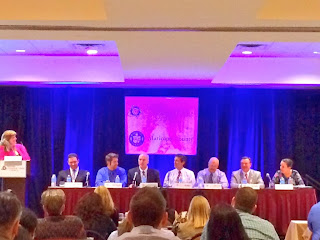Even an oncoming haboob couldn’t
stop this guy- from his time in the House through today, U.S. Senator
Jeff Flake has always insisted that the federal government listen to Arizona on
the critical issues that affect our state.
He proved this once again today by organizing an
Arizona-only listening session with the Environmental Protection Agency and
Arizona stakeholders to discuss the forthcoming content of the EPA’s draft rule
on the process by which so-called “exceptional events” related to air quality
standards are submitted to the EPA for review. Sen.
Flake hosted a stakeholder meeting back in September at the Arizona Chamber to
discuss this same issue, and this was a chance for stakeholders to voice their
concerns directly to EPA staff.
The Arizona business community has concerns about the
economic impact of this exceptional events rule, especially the non-attainment
issue and the cost to the state.
As we all know, Arizona has a unique desert environment
where dust storms or “haboobs”
frequently roll through during our summer months. These exceptional events occur
regularly in Arizona, and contribute to artificially high air quality readings
that have the potential to place counties in non-attainment. A non-attainment
designation could have lasting economic consequences on cities, towns and
businesses in Arizona. Federal transportation projects are put on strict
budgets and often ruled out in non-attainment areas.
The possibility of being placed in non-attainment also
presents a lot of uncertainty for businesses in the area. Businesses operating
in non-attainment areas already face some of the most stringent regulations in
the nation for dust and PM10. Without exceptional event findings, these
businesses will be subject to draconian-like regulations. We simply cannot
afford tighter restrictions on business. The timeframes for air quality permits
also increase when an area has been placed in non-attainment. As Arizona is
still climbing out of the recession, we have to be able to get businesses off
the ground and running.
Some of these storms in recent years have made international
news. These events are no doubt exceptional, but the state is still tasked
with proving to the EPA that they contributed to our higher-than-normal air
quality readings. These demonstrations are a cost that the agency has to
absorb. The Department of Environmental Quality and Maricopa County Air Quality
Division have done an excellent job of streamlining this process. And although this partnership has resulted in considerable
enhancements, the investment required to handle this documentation process
remains unsustainable.
To address these issues, Sen.
Flake has recommended that the EPA adopt an exceptional events rule that:
- Specifies regionally tailored criteria for evidence, analyses, and documentation applicable to EPA’s approval or disapproval of an exceptional event demonstration;
- Creates a strict timeline by which EPA must review and rule on every exceptional event demonstration submission;
- Ensures that EPA’s approval of an exceptional event demonstration be based upon a preponderance of the evidence. In other words, if the state supplies sufficient evidence to prove an exceptional event was more likely than not responsible for an exceedance, EPA ought to approve the demonstration;
- And, allows for states to appeal any EPA decision to disapprove an exceptional event demonstration.
We want to thank Sen. Flake for organizing this opportunity for Arizona business and agricultural stakeholders to voice their comments and concerns and ask questions about the draft rule.





